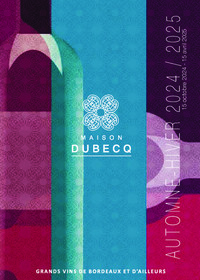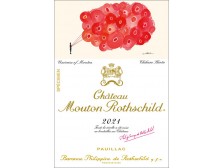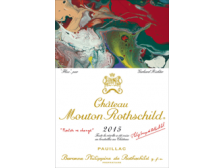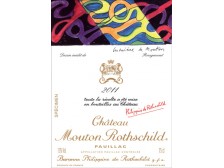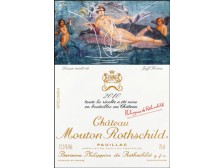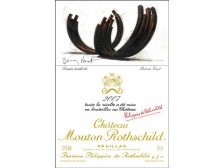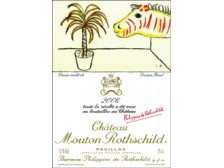Catalog
-
Contiguous to Mouton-Rothschild, Pontet-Canet is in good vintages the very type of great Pauillac, straight and racy. The first of the Grands Crus Classés to be certified "organic" (in 2010), Pontet-Canet has been at the top of the Médoc since 2000.
The 2008 vintage in the press:
Vinous (N. Martin - February 2020): 92/100 "A meeting by chance with the 2008 Pontet-Canet prior to a small tasting of South African wines reminded me what a lovely wine this is. There is plenty of black fruit on the nose laced with graphite. The cedar component is less prominent than the previous bottled tasting. The palate is medium-bodied, a little drier and more austere than recent vintages, yet clearly well balanced with a surfeit of freshness on the slightly herbaceous finish."
More- To keep or to drink:
- Ready to drink
- Apogée:
- 2020-2030
- Potential alcohol:
- 13%
- Organic certification:
- 2010
-
Contiguous to Mouton-Rothschild, Pontet-Canet is in good vintages the very type of great Pauillac, straight and racy. The first of the Grands Crus Classés to be certified "organic" (in 2010), Pontet-Canet has been at the top of the Médoc since 2000.
The 2006 vintage in the press:
La Revue du Vin de France (2016): 17.5/20 “Very nice, subtle length.”
Wine Advocate (2016): 93/100
Vinous (S. Tanzer - May 2009): 94/100 "Satured medium ruby. Inky cassis, black raspeberry, graphite and pungent minerality on the very ripe nose. Dense, riche and silky, with a brooding inky minerality and an almost liqueur-like dark fruit sweetness leavened by a savory peppery element. This very ripe, deep and concentrated wine boasts wonderful lushness without any undue weight thanks to its sheer energy like its neighbor Mouton-rothschild, Pontet-Canet's 2006 conveys a powerful impression of soil character. Finishes with serious dusty tannins and superb lingering sweetness. Should be long-lived."
More- To keep or to drink:
- Ready to drink
- Apogée:
- 2015-2028
- Potential alcohol:
- 13%
-
Bought in 1986 by the AXA group, initially under the leadership of Mr. Cazes (Lynch-Bages), Pichon-Longueville Baron regained its best form in the powerful and distinguished style of the great Pauillac. It must be said that a small half of its vines are located next to those of Latour, on a first growth terroir! For the Revue du Vin de France: "Pichon-Baron is at the top in the last vintages".
The 2022 vintage in the press:
Vinous (A. Galloni - January 2025): 98/100 "The 2022 Pichon Baron is one of the most elegant, polished wines I have ever tasted here. Silky and refined, the 2022 is super-impressive right out of the gate. The aromatics alone are mesmerizing. Blood orange, herbs and floral notes lend notable delineation to a core of Cabernet Sauvignon fruit. As I did en primeur, I find the wine's balance nothing short of exquisite. There's more freshness and vibrancy here than in the past, along with a noticeably lower oak imprint and more sensual tannins that lend notable sophistication throughout. The Grand Vin spent 16 months in French oak barreks, 70% new, and then two months in wood cats prior to bottling."
J-M Quarin (February 2025): 99/100 "Black colour, intense and lively. The nose starts off a little subdued, before developing in the glass, fine, subtle, deep and complex. Nuances of black fruit and spices. Full-bodied from the outset, then immediately dense, with a fine fatness that runs across the palate combined with an exuberant black fruit flavour, the wine evolves serenely over a noble yet tight tannic structure. Great complex persistence. A great, powerful Pichon Baron, with a rare mellowness. For the moment, the best ever made with the 2016."
More- To keep or to drink:
- Wait 5 to 10 years
- Apogée:
- 2030-2045
-
Bought in 1986 by the AXA group, initially under the leadership of Mr. Cazes (Lynch-Bages), Pichon-Longueville Baron regained its best form in the powerful and distinguished style of the great Pauillac. It must be said that a small half of its vines are located next to those of Latour, on a first growth terroir! For the Revue du Vin de France: "Pichon-Baron is at the top in the last vintages".
The 2021 vintage in the press:
La Revue du Vin de France (Guide 2025): 96/100 “It has digested its ageing admirably and is endowed with a luminous, radiant body, with lots of rebounding flavors on the palate.”
Vinous (A. Galloni - December 2023): 96/100 “Dark and brooding in bearing, the 2021 Pichon Baron is a somber, mysterious wine. It is every bit as impressive as it was en primeur. Graphite, leather, spice, mocha and dried herbs meld together in a wine of power, precision and contemporary classicism. It's one of my early favorites in this vintage. I won't be too surprised if it turns out even than this note suggests.”
More- To keep or to drink:
- Wait 5 to 10 years
- Apogée:
- 2030-2045
-
Bought in 1986 by the AXA group, initially under the leadership of Mr. Cazes (Lynch-Bages), Pichon-Longueville Baron regained its best form in the powerful and distinguished style of the great Pauillac. It must be said that a small half of its vines are located next to those of Latour, on a first growth terroir! For the Revue du Vin de France: "Pichon-Baron is at the top in the last vintages".
The 2018 vintage in the press:
En Magnum (April 2021): 98/100 “Great color, great generosity of substance, absolute ripeness of the grape, noble cedar flavor, assertive solar character, but without imbalance. Baron is true to itself, undeniably Pauillac."
La Revue du Vin de France (Guide 2021): 97/100 “Superb matter, concentrated, energetic and deep. Impresses with its length and persistent aromas.”
More- To keep or to drink:
- Wait 5 to 10 years
- Apogée:
- 2030-2045
-
Bought in 1986 by the AXA group, initially under the leadership of Mr. Cazes (Lynch-Bages), Pichon-Longueville Baron regained its best form in the powerful and distinguished style of the great Pauillac. It must be said that a small half of its vines are located next to those of Latour, on a first growth terroir! For the Revue du Vin de France: "Pichon-Baron is at the top in the last vintages".
The 2017 vintage in the press:
J-M Quarin (October 2020): 96/100 “Dark, intense and beautiful color. Very aromatic nose, fruity, creamy and slightly truffled. Meticulous on entry, refined to the touch, very aromatic, the wine develops on a graceful general bearing. It melts in the finish, fragrant, long, sappy and very good”.
Vinous (A. Galloni - March 2020): 94+/100“The 2017 Pichon-Baron has become a powerful wine, even by its own standards. Black cherry, plum, chocolate, grilled herbs, licorice, new leather and spices blossom in a succulent Pauillac that shows the racy personality of the year.”
More- To keep or to drink:
- Ready to drink
- Apogée:
- 2025-2037
-
Bought in 1986 by the AXA group, initially under the leadership of Mr. Cazes (Lynch-Bages), Pichon-Longueville Baron regained its best form in the powerful and distinguished style of the great Pauillac. It must be said that a small half of its vines are located next to those of Latour, on a first growth terroir! For the Revue du Vin de France: "Pichon-Baron is at the top in the last vintages".
The 2016 vintage in the press:
Vinous (N. Martin - January 2020): 93+/100 "The 2016 Pichon Baron has a powerful, menthol-scented bouquet that almost overwhelms the senses. This comes across richer than its peers, almost heady in style. The palate is medium-bodied with thick tannins, layers of rich black fruit laced with pencil lead and a dash of white pepper. An extravagant Pauillac with an uncharacteristically hedonistic finish. Superb, but I have had better bottles."
La Revue du Vin de France (2018): 97/100 “monumental.”
More- To keep or to drink:
- Ready to drink
- Apogée:
- 2025-2040
-
Bought in 1986 by the AXA group, initially under the leadership of Mr. Cazes (Lynch-Bages), Pichon-Longueville Baron regained its best form in the powerful and distinguished style of the great Pauillac. It must be said that a small half of its vines are located next to those of Latour, on a first growth terroir! For the Revue du Vin de France: "Pichon-Baron is at the top in the last vintages".
The 2010 vintage in the press:
Vinous (N. Martin - February 2020): 96/100 "The 2010 Pichon-Baron is simply one of the greatest wines produced under Christian Seely's tenure. It has a stunning bouquet with penetrating black fruit, wilted violet and a touch of sea spray, a distinctive marine note verging on shucked oyster shells. The palate is very well balanced with fine grain tannins, layers pf graphite infused black fruit and a very detailed, captivating finish. Brilliant."
More- To keep or to drink:
- Ready to drink
- Apogée:
- 2022-2035
-
Mr Rouzaud (Champagne Roederer) acquired it in 2007 and has since strengthened the technical team by adding the advice of Mr Boissenot. Pichon-Comtesse remains faithful to the style that has made it so successful, as dense, suave, charming, enchanting and above all endearing.
The 2020 vintage in the reviews :
La Revue du Vin de France (2024 Guide) : 99/100 "Pure class! This 2020 unfurls a subtle, silky, meticulous texture, with vibrant berry notes and an absolute delicacy in its mouthfeel. Velvety tannins bring supreme refinement to the finish."
Vinous (Neal Martin - November 2024) : 99/100 and #3 of the Top 100 wines of 2024 "The 2020 Pichon-Longueville Comtesse de Lalande has one of the more opulent aromatic profiles amongst the flight of Pauillac wines, displaying black cherries, cassis, graphite and cedar. The palate is medium-bodied with svelte tannins and a silver bead of acidity. Silky smooth in texture, this retains impressive composure toward the finish, handling the weight of fruit with class. It imroves with each swirl, though the bottle I tasted just after bottling had a touch more precision. Nevertheless, this a fabulous Pauillac that flirts with perfection."
More- To keep or to drink:
- Wait 3 to 5 years
- Apogée:
- 2022-2040
-
Mr Rouzaud (Champagne Roederer) acquired it in 2007 and has since strengthened the technical team by adding the advice of Mr Boissenot. Pichon-Comtesse remains faithful to the style that has made it so successful, as dense, suave, charming, enchanting and above all endearing.
The 2019 vintage in the press:
La Revue du Vin de France (Guide 2023): 97/100 “The big Cabernets (Sauvignon and Franc) provide the backbone to the wine. On the palate, the wine is precise but not austere, with the usual velvety finish."
Vinous (N. Martin - January 2023): 98/100 “The 2019 Pichon-Longueville Comtesse de Lalande demands more coaxing from the glass, but it rewards patience with compelling graphite-infused black fruit, unapologetically classic in style, the terroir flooding through. The palate is medium-bodied with wonderful sapidity, gorgeous balance and a pure yet powerful finish that makes you wish you could build a time machine and taste it in 20 years. Sublime.”
More- To keep or to drink:
- Ready to drink
- Apogée:
- 2023-2040
-
Mr Rouzaud (Champagne Roederer) acquired it in 2007 and has since strengthened the technical team by adding the advice of Mr Boissenot. Pichon-Comtesse remains faithful to the style that has made it so successful, as dense, suave, charming, enchanting and above all endearing.
The 2016 vintage in the press:
Vinous (N. Martin - January 2020): 97/100 "The 2016 Pichon-Longueville Comtesse de Lalande is very expressive on the nose, displaying more red fruit than the 2016 Lynch-Bages, but retaining classic Pauillac style thanks to tobacco and cedar scents that manifest with aeration. The palate is medium-bodied with supple tannins and a fine bead of acidity. Very harmonious, leading to a pure and very detailed, almost pixelated finish that is utterly seductive."
More- To keep or to drink:
- Ready to drink
- Apogée:
- 2023-2040
-
Mr Rouzaud (Champagne Roederer) acquired it in 2007 and has since strengthened the technical team by adding the advice of Mr Boissenot. Pichon-Comtesse remains faithful to the style that has made it so successful, as dense, suave, charming, enchanting and above all endearing.
The 2010 vintage in the press:
Vinous (N. Martin - February 2020): 94/100 "The 2010 Pichon-Longueville Comtesse de Lalande is again, very deep in colour. It has a compact nose that demands aeration, opening up with blackberry, raspberry coulis, graphite and light iris aromas, all well defined but implying that it has more to give in the future. The palate is medium-bodied with firm tannins, a fine bead of acidity, a little peppery in style with a smooth and harmonious, more Saint-Julien like finish. it is an extremely charming and drinkable Pauillac though."
More- To keep or to drink:
- Ready to drink
- Apogée:
- 2022-2040
-
The young vines of Latour being reserved for the simple 'Pauillac' of the estate, the second wine, Les Forts de Latour, can be qualified as a great wine in its own right, coming from the plots of land outside the enclosure of Château Latour.
The 2014 vintage in the press:
Vinous (N. Martin - February 2024): 93/100 “The 2014 Les Forts de Latour has one of the most impressive aromatics amongst the Pauillac, with blackberry, cedar and cassis notes. A touche of pencil lead comes through with aeration. The palate is medium-bodied with firm tannins. It's fresh and saline, with brisk graphite-infused black fruit towards the persistent, fleshy, silky finish. Outstanding for a Deuxième Vin."
More- To keep or to drink:
- Ready to drink
- Apogée:
- 2025-2040
-
The young vines of Latour being reserved for the simple 'Pauillac' of the estate, the second wine, Les Forts de Latour, can be qualified as a great wine in its own right, coming from the plots of land outside the enclosure of Château Latour.
The 2009 vintage in the press:
Vinous (N. Martin - March 2018): 91/100 “The palate is clean and fresh with very fine, almost nervous tannins. The precision here is undeniable, a taut Les Forts de Latour that like many 2012s has blossomed during its bottle ageing. A touch of Pauillac mint appears on the finish.”
More- To keep or to drink:
- Ready to drink
- Apogée:
- 2021-2036
-
Mouton-Rothschild's second wine, which appeared in 1993, has since made its place among its peers (Carruades de Lafite, Forts de Latour, Pavillon Rouge) by offering each vintage a great Pauillac, full, fleshy, muscular, barely less deep and full-bodied than its famous big brother but with the same cassis finish. Petit Mouton has grown up!
The 2022 vintage in the press:
Vinous (A. Galloni - January 2025): 91/100 "The 2022 Le Petit-Mouton is a rich, powerful wine, almost exaggeratedly so in this vintage. A blast of dark cherry, plum, leather, cloves and licorice stains the palate with notable resonance. There's a lot of wine here, but the 2022 is going to need quite a few years to shed some of its considerably youthfulness. The long, sustained finish is very promising."
J-M Quarin (February 2025): 93/100 "Beautiful dark red colour. Intense, ripe fruity nose, particularly smoky when the glass is shaken. Juicy on the attack, suave in the middle palate, with a distinguished touch, the wine rises in the finish, deep, flavoursome and long."
More- To keep or to drink:
- Wait 3 to 5 years
- Apogée:
- 2030-2044
-
Mouton-Rothschild's second wine, which appeared in 1993, has since made its place among its peers (Carruades de Lafite, Forts de Latour, Pavillon Rouge) by offering each vintage a great Pauillac, full, fleshy, muscular, barely less deep and full-bodied than its famous big brother but with the same cassis finish. Petit Mouton has grown up!
The 2020 vintage in the press:
Vinous (N.Martin - November 2024): 94/100 “The 2020 Le Petit Mouton has a seductive bouquet with a mixture of red and black fruit, cedar and pencil lead, seeming to gain precision in the glass-very classic in style. the palate is medium-bodied with a sweet core of cassis and blackberry fruit, very composed and very pure. A cashmere-textured finish fans out gloriously. This is a seriously fine Pauillac for long-term cellaring (written before its identity was revealed).”
Bettane et Desseauve (Guide 2024): 94/100
More- To keep or to drink:
- Wait 5 to 10 years
- Apogée:
- 2030-2044
-
Mouton-Rothschild's second wine, which appeared in 1993, has since made its place among its peers (Carruades de Lafite, Forts de Latour, Pavillon Rouge) by offering each vintage a great Pauillac, full, fleshy, muscular, barely less deep and full-bodied than its famous big brother but with the same cassis finish. Petit Mouton has grown up!
The 2018 vintage in the press:
Vinous (A. Galloni - March 2021): 93/100 "Just as it was from barrel, the 2018 Le Petit-Mouton is fleshy, radiant and very easy to enjoy. Soft contours and silky tannins add to its considerable allure. Because of low yields, the Petit-Mouton was aged entirely in new oak. Rich, sumptuous and bold to the core, the 2018 is a rock star wine."
More- To keep or to drink:
- Wait 1 to 2 years
- Apogée:
- 2030-2044
-
Mouton-Rothschild's second wine, which appeared in 1993, has since made its place among its peers (Carruades de Lafite, Forts de Latour, Pavillon Rouge) by offering each vintage a great Pauillac, full, fleshy, muscular, barely less deep and full-bodied than its famous big brother but with the same cassis finish. Petit Mouton has grown up!
The 2017 vintage in the press:
Vinous (A. Galloni - December 2019): 92+/100 "The 2017 Le Petit-Mouton is endowed with tremendous richness and intensity. Deep, ample and structured, it is brimming with inky red and purplish berry fruit, pomegranate, spice, leather, blood orange, white pepper and wild flowers. The potent, plush 2017 is full of explosive energy that is just waiting to be unleashed."
More- To keep or to drink:
- Ready to drink
- Apogée:
- 2030-2044
-
Second wine of Lafite-Rothschild.
The 2022 vintage in the press:
Vinous (A. Galloni - January 2025): 93/100 "The 2022 Carruades de Lafite is a dense, full-throttle Pauillac. Far from an easygoing second wine, the 2022 Carruades is going to need a number of years to be at its best. It's an almost shockingly powerful wine endowed with serious balance and tons of class. Touches of Cabernet Franc and Petit Verdot lend hints of spice to round out the blend. The 2022 is stellar. I may very well be underrating it today."
J.M Quarin (February 2025): 95/100 "Dark, intense and beautiful colour. Very aromatic, fine, subtle nose. A touch of very ripe fruit. A hint of caramel. Ample on the attack, suave on the mid-palate, particularly aromatic, the wine caresses the palate before filling out on the finish, long, sappy, fine and very greedy."
More- To keep or to drink:
- Wait 10 years and more
- Apogée:
- 2030-2050
- Organic certification:
- 2024
- More
- To keep or to drink:
- Wait 10 years and more
- Apogée:
- 2030-2050
-
Mouton-Rothschild's upgrade in 1973 from second to first grand cru classé was as legitimate as it was deserved in view of the quality of its terroir, a plateau of 90 hectares of deep gravel to the north of Pauillac, with Lafite-Rothschild as a neighbor. Despite this promotion, and even though it regularly tops the rankings in tastings, Mouton-Rothschild remains to this day the least expensive of the Médoc's premier crus classés. Its powerful, full-bodied style and its ability to age well have led Mr. Bettane to write "perhaps the most formally perfect wine in the Médoc...".
The 2021 vintage in the press:
La Revue du Vin de France (Guide 2025): 97/100 “This Pauillac displays great distinction. The Cabernets (90%) are admirably defined. The wine coats the palate and delivers a fresh balance (12.8°). The quality of the tannins is magnificent, with a very fine touch and great suavity.”
More- To keep or to drink:
- Wait 5 to 10 years
- Apogée:
- 2028-2050
-
Mouton-Rothschild's upgrade in 1973 from second to first grand cru classé was as legitimate as it was deserved in view of the quality of its terroir, a plateau of 90 hectares of deep gravel to the north of Pauillac, with Lafite-Rothschild as a neighbor. Despite this promotion, and even though it regularly tops the rankings in tastings, Mouton-Rothschild remains to this day the least expensive of the Médoc's premier crus classés. Its powerful, full-bodied style and its ability to age well have led Mr. Bettane to write "perhaps the most formally perfect wine in the Médoc...".
The 2015 vintage in the press:
Vinous (N. Martin - January 2019): 95/100 "The 2015 Mouton-Rothschild has more fruit intensity on the nose than the 2015 Château Margaux and also more red than black fruit: the raspberry and wild strawberry scents are more expressive than the blackberry and biary ones. The oak is neatly integrated here, altough I would have loked a little more delineation. The palate is medium-bodied with supple tannin and vivacious red and black fruit, though it is the silky texture that really wins you over. There's not a single hair out of place on the finish."
More- To keep or to drink:
- Wait 5 to 10 years
- Apogée:
- 2030-2045
- Potential alcohol:
- 13.5%
-
Mouton-Rothschild's upgrade in 1973 from second to first grand cru classé was as legitimate as it was deserved in view of the quality of its terroir, a plateau of 90 hectares of deep gravel to the north of Pauillac, with Lafite-Rothschild as a neighbor. Despite this promotion, and even though it regularly tops the rankings in tastings, Mouton-Rothschild remains to this day the least expensive of the Médoc's premier crus classés. Its powerful, full-bodied style and its ability to age well have led Mr. Bettane to write "perhaps the most formally perfect wine in the Médoc...".
The 2011 vintage in the press:
Vinous (N. Martin - September 2021): 92/100 "The 2011 Mouton-Rothschild feels surprisingly reduced on the nose and needed a lot of coaxing. Leather, mocha, liquorice develops in the glass, quite bretty compared to its peers. The palate is medium-bodied, fleshy and ripe, that mocha translating over from the nose, minty with touches of white pepper on the finish. A very decent Pauillac, a solid rather than spectacular effort from Mouton this year."
More- To keep or to drink:
- Wait 3 to 5 years
- Apogée:
- 2028-2042
- Potential alcohol:
- 13.5%
-
Mouton-Rothschild's upgrade in 1973 from second to first grand cru classé was as legitimate as it was deserved in view of the quality of its terroir, a plateau of 90 hectares of deep gravel to the north of Pauillac, with Lafite-Rothschild as a neighbor. Despite this promotion, and even though it regularly tops the rankings in tastings, Mouton-Rothschild remains to this day the least expensive of the Médoc's premier crus classés. Its powerful, full-bodied style and its ability to age well have led Mr. Bettane to write "perhaps the most formally perfect wine in the Médoc...".
The 2012 vintage « a major success of the vintage » has obtained 94/100 by Wine Advocate.
More- To keep or to drink:
- Wait 3 to 5 years
- Apogée:
- 2028-2050
- Potential alcohol:
- 13.5%
-
Mouton-Rothschild's upgrade in 1973 from second to first grand cru classé was as legitimate as it was deserved in view of the quality of its terroir, a plateau of 90 hectares of deep gravel to the north of Pauillac, with Lafite-Rothschild as a neighbor. Despite this promotion, and even though it regularly tops the rankings in tastings, Mouton-Rothschild remains to this day the least expensive of the Médoc's premier crus classés. Its powerful, full-bodied style and its ability to age well have led Mr. Bettane to write "perhaps the most formally perfect wine in the Médoc...".
The 2007 vintage in the press:
Vinous (A. Galloni - January 2016): 94/100 "The 2007 Mouton-Rothschild is a gorgeous wine, especially within the context of the vintage. Open, expressive aromatics and forward fruit make the 2007 an excellent choice for drinking now and over the next two decades or so. Although the 2007 is not an epic Mouton, it is without question one of the best recent vintages for current drinking. Smoke, tobacco, cedar and licorice add the closing shades of nuance."
More- To keep or to drink:
- Ready to drink
- Apogée:
- 2019-2032
- Potential alcohol:
- 13%
-
Mouton-Rothschild's upgrade in 1973 from second to first grand cru classé was as legitimate as it was deserved in view of the quality of its terroir, a plateau of 90 hectares of deep gravel to the north of Pauillac, with Lafite-Rothschild as a neighbor. Despite this promotion, and even though it regularly tops the rankings in tastings, Mouton-Rothschild remains to this day the least expensive of the Médoc's premier crus classés. Its powerful, full-bodied style and its ability to age well have led Mr. Bettane to write "perhaps the most formally perfect wine in the Médoc...".
The 2006 vintage in the press:
Vinous (A. Galloni - January 2016): 92/100 "The 2006 Mouton-Rothschild is dark, powerful and intense, with firm tannins that need time to soften. This is an especially dark, somber Mouton. dark black fruit, smoke, menthol gravel and cured meats are some of the signatures. Slight vegetal notes underpin the fruit. I am not sure the 2006 has enough freshness to be a long-term ager or the depth of fruit to outlast tannins."
More- To keep or to drink:
- Ready to drink
- Apogée:
- 2020-2036
- Potential alcohol:
- 13%
-
Appointed cellar master in 1994, Mr. Chevallier focused on developing Lafite-Rothschild wines without losing any of the characteristic bouquet of blackcurrant, graphite and cedar. This objective was quickly achieved, placing Lafite at the top of the 1st classified growths (this was already the case in 1855), and revered as such by the Chinese market. The incredible qualities of Lafite's terroir make it a unique vintage and give Cabernet Sauvignon (more than 90% present each year) its most beautiful aromatic expressions.
The great 2020 vintage was awarded the supreme score of 100/1000 by the Revue du Vin de France: "Spectacular, bordering on perfection".
The 2020 vintage in the press:
Hachette (Guide 2024) : Coup de ♥ “With admirable depth, a Lafite on elegance rather than power.”
La Revue du Vin de France (November 2023): 100/100 “Spectacular and verging on perfection. It shows absolute distinction and elegance. The pinnacle of Cabernet aristocracy, falling into the mouth like a tailor-made suit. The alliance of power and elegance”.
Bettane et Desseauve (Guide 2024): 98/100
Vinous (N. Martin - December 2022): 98/100 "The 2020 Lafite-Rothschild, which contains the highest proportion of Merlot since the 2016, hit the bull's eye from barrel. Revisiting the wine in the bottle since July, it still bursts from the glass with copious blackberries, touches of bluberry and juniper, pencil lead of crushed stone. Wonderful delineation. The palate is medium-bodied with finely-chiseled tannins, quite linear and "correct"- aquintessential Lafite-Rothschild in many ways. It gently builds in the mouth while keeping a restraint on things, finishing with fine sapidity yet a little more juiciness than you would have found a decade or two earlier. This has the potential to evolve beautifully over several decades."
More- To keep or to drink:
- Wait 10 years and more
- Apogée:
- 2030-2050
-
Appointed cellar master in 1994, Mr. Chevallier focused on developing Lafite-Rothschild wines without losing any of the characteristic bouquet of blackcurrant, graphite and cedar. This objective was quickly achieved, placing Lafite at the top of the 1st classified growths (this was already the case in 1855), and revered as such by the Chinese market. The incredible qualities of Lafite's terroir make it a unique vintage and give Cabernet Sauvignon (more than 90% present each year) its most beautiful aromatic expressions.
The great 2020 vintage was awarded the supreme score of 100/1000 by the Revue du Vin de France: "Spectacular, bordering on perfection".
The 2008 vintage in the press:
Vinous (N. Martin - March 2018): 94/100 "The 2008 Lafite-Rothschild put in a strange showing at the previous horizontal just a few weeks earlier. This bottle is much better. it has a deep color with little ageing on the rim. On the nose there is ample fruit, blackberry and bilberry with notes of pencil lead and sage, but overall there is just more intensity than the previous bottle. The palate is well balanced with fine grain tannin and good density, a facet occasionally lacking in Lafite-Rothschild. There is just a touch of brown sugar and sage towards the finish that fortunately does not attenuate like the previous bottle. This is much more representative and whilst not the best First Growth of the vintage, it certainly shows more sophistication and class even if it does not match its more stellar showings just after bottling."
More- To keep or to drink:
- Ready to drink
- Apogée:
- 2020-2033
- Potential alcohol:
- 12.5%
-
Appointed cellar master in 1994, Mr. Chevallier focused on developing Lafite-Rothschild wines without losing any of the characteristic bouquet of blackcurrant, graphite and cedar. This objective was quickly achieved, placing Lafite at the top of the 1st classified growths (this was already the case in 1855), and revered as such by the Chinese market. The incredible qualities of Lafite's terroir make it a unique vintage and give Cabernet Sauvignon (more than 90% present each year) its most beautiful aromatic expressions.
The great 2020 vintage was awarded the supreme score of 100/1000 by the Revue du Vin de France: "Spectacular, bordering on perfection".
The 2007 vintage in the press:
Vinous (N. Martin - March 2018): 93/100 "The 2007 Lafite-Rothschild is a strong performer in what was a challenging growing season. At 11 years of age the 2007 is beginning to drink well with blackberry, briary, graphite and smoke on the nose, perhaps still that old touch of antique buerau. The palate is medium-bodied with fine-grain tannins and tobacco, well balanced yet typically understated on the finish. The 2007 is not the greatest Lafite-Rothschild for sure, but it should offer 15 to 20 years of drinking pleasure."
More- To keep or to drink:
- Ready to drink
- Apogée:
- 2014-2028
- Potential alcohol:
- 12.5%
-
Appointed cellar master in 1994, Mr. Chevallier focused on developing Lafite-Rothschild wines without losing any of the characteristic bouquet of blackcurrant, graphite and cedar. This objective was quickly achieved, placing Lafite at the top of the 1st classified growths (this was already the case in 1855), and revered as such by the Chinese market. The incredible qualities of Lafite's terroir make it a unique vintage and give Cabernet Sauvignon (more than 90% present each year) its most beautiful aromatic expressions.
The great 2020 vintage was awarded the supreme score of 100/1000 by the Revue du Vin de France: "Spectacular, bordering on perfection".
The 1999 vintage in the press:
Vinous (N. Martin - September 2019): 92/100 "Personally, I have liked this First Growth since I first tasted it in barrel. Now 20 years old, it is beginning to show a little bricking ion the rim. The bouquet is clean and detailed, with black currant, raspberry, melted tar and cedardeveloping in the glass (but less of the allspice that I observed in previous bottles). The palate is medium-bodied and maybe more compact than expected, possibly due to this being ex-cellar. While not a concentrated Lafite-Rothschild, it is very harmonious and elegant, brushed with a subtle pepperiness toward the finish and a tang of dried orange peel on the aftertaste. Delightful."
More- To keep or to drink:
- Ready to drink
- Apogée:
- 2010-2024
- Potential alcohol:
- 12.5%



